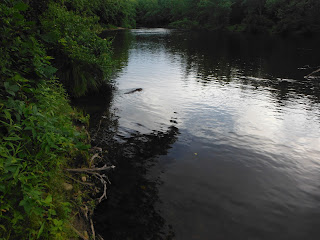Several years ago I was sitting with Dave Valle, a former Major League catcher, in the stands of an amateur field in San Pedro de Macoris, the Dominican Republic. The DR, and San Pedro de Macoris more particularly, have become famous because it is where the Big Leagues is finding many of its biggest talents.
I sat there innocently watching what I took to be a typical baseball game, but Dave was seeing more than I could ever see by scanning the field pitch-by-pitch, movement-by-movement. He was a real professional taking in a scene he had seen and learned from hundreds if not thousands of times before. He noticed the first baseman out of position, and the batters tendencies and the foibles of the pitcher and the athleticism of middle infielder.
It was kind of like that fishing with my guide on the Farmington. Shawn Britton stood waist-deep in the Farmington one morning this week absorbing in a flash 5-6 different hatches, fish rises, wildlife, my sorry casting, currents and wind direction. I was noticing one thing while he took in dozens of things. A true pro, and a nice guy as well.
We didn't catch any fish together, but my only regret is that I didn't set my rod down and just learn from him. He is the buggiest guy I've ever met. He could spot bugs all around him and then quickly match them with a fly in his box.
At one point he asked, as I was furiously casting, if I ever shook trees. What he meant was do I ever take the time to shake a tree to see what insects will fall, thereby attracting fish. Why didn't I just set the rod down and go do that with him? I would have learned something. If you're lucky enough to book time with Shawn it's like enrolling in a fly fishing course. He knows these waters -- not just the currents and the rocks -- but the natural history and the cultural history -- like the back of his hand.
This was my first fly fishing experience on the East Coast. When I called a few fly shops in the Boston area to enquire about where to fish on my day off, the Farmington kept coming up as a top recommendation. It has brown and brook trout as well small Atlantic salmon that the federal government is trying to reintroduce.
There is a great book on fishing the Farmington at the Farmington River Anglers Association website. Shawn is one of the writers and editors.
I booked a room at the Old Riverton Inn, a historic, care-worn fishing lodge just across the lane from the Farmington. With its old bridges, colonial houses and white picket fences, this is a charming New England fishing experience.
The water was ice cold and clear in late June. The river is not wide and is very wadeable. The flows are good but not too swift.
The evening before meeting Shawn I caught a few small brown trout beneath the bridge just across from the Inn. And then in the afternoon after Shawn and I said goodbye I caught this nice brown trout swinging a fly at People's State Forest. This was my first decent brown trout ever -- about 12-13 inches. I was using one of Shawn's terrestrials -- a small black fly with white wings.
Earlier in the morning, as Shawn was giving me a tour of the river, we saw this beaver which you can see swiming from the left bank of the Farmington.
I wanted to mention that I stopped in Wareham, Mass, on my way to the Cape to check out a small fishery that Trout Unlimited has been excited about. The local TU is reintroducing searun brook trout in the tiny, scenic brook which runs into Buttermilk Bay (just off Buzzards Bay). the section I walked is part of the Lyman Trust.
Find Red Brook road off the Cranberry Highway and you will find the reserve.
Check out this website for a description of the project to save this historic, endangered species of salters.

























